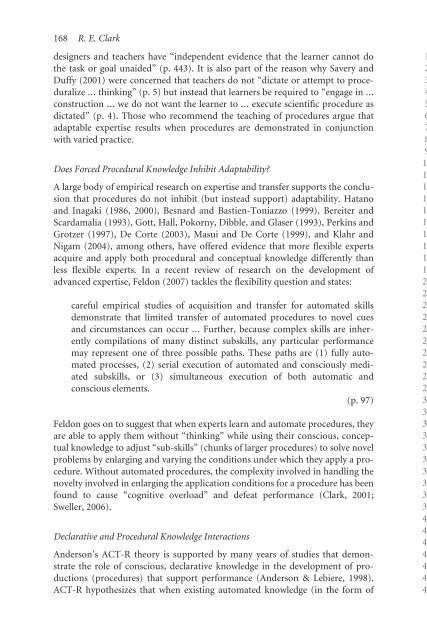9 How Much and What Type of Guidance is Optimal for Learning ...
9 How Much and What Type of Guidance is Optimal for Learning ...
9 How Much and What Type of Guidance is Optimal for Learning ...
You also want an ePaper? Increase the reach of your titles
YUMPU automatically turns print PDFs into web optimized ePapers that Google loves.
168 R. E. Clarkdesigners <strong>and</strong> teachers have “independent evidence that the learner cannot dothe task or goal unaided” (p. 443). It <strong>is</strong> also part <strong>of</strong> the reason why Savery <strong>and</strong>Duffy (2001) were concerned that teachers do not “dictate or attempt to proceduralize. . . thinking” (p. 5) but instead that learners be required to “engage in . . .construction . . . we do not want the learner to . . . execute scientific procedure asdictated” (p. 4). Those who recommend the teaching <strong>of</strong> procedures argue thatadaptable expert<strong>is</strong>e results when procedures are demonstrated in conjunctionwith varied practice.Does Forced Procedural Knowledge Inhibit Adaptability?A large body <strong>of</strong> empirical research on expert<strong>is</strong>e <strong>and</strong> transfer supports the conclusionthat procedures do not inhibit (but instead support) adaptability. Hatano<strong>and</strong> Inagaki (1986, 2000), Besnard <strong>and</strong> Bastien- Toniazzo (1999), Bereiter <strong>and</strong>Scardamalia (1993), Gott, Hall, Pokorny, Dibble, <strong>and</strong> Glaser (1993), Perkins <strong>and</strong>Grotzer (1997), De Corte (2003), Masui <strong>and</strong> De Corte (1999), <strong>and</strong> Klahr <strong>and</strong>Nigam (2004), among others, have <strong>of</strong>fered evidence that more flexible expertsacquire <strong>and</strong> apply both procedural <strong>and</strong> conceptual knowledge differently thanless flexible experts. In a recent review <strong>of</strong> research on the development <strong>of</strong>advanced expert<strong>is</strong>e, Feldon (2007) tackles the flexibility question <strong>and</strong> states:careful empirical studies <strong>of</strong> acqu<strong>is</strong>ition <strong>and</strong> transfer <strong>for</strong> automated skillsdemonstrate that limited transfer <strong>of</strong> automated procedures to novel cues<strong>and</strong> circumstances can occur . . . Further, because complex skills are inherentlycompilations <strong>of</strong> many d<strong>is</strong>tinct subskills, any particular per<strong>for</strong>mancemay represent one <strong>of</strong> three possible paths. These paths are (1) fully automatedprocesses, (2) serial execution <strong>of</strong> automated <strong>and</strong> consciously mediatedsubskills, or (3) simultaneous execution <strong>of</strong> both automatic <strong>and</strong>conscious elements.(p. 97)Feldon goes on to suggest that when experts learn <strong>and</strong> automate procedures, theyare able to apply them without “thinking” while using their conscious, conceptualknowledge to adjust “ sub- skills” (chunks <strong>of</strong> larger procedures) to solve novelproblems by enlarging <strong>and</strong> varying the conditions under which they apply a procedure.Without automated procedures, the complexity involved in h<strong>and</strong>ling thenovelty involved in enlarging the application conditions <strong>for</strong> a procedure has beenfound to cause “cognitive overload” <strong>and</strong> defeat per<strong>for</strong>mance (Clark, 2001;Sweller, 2006).Declarative <strong>and</strong> Procedural Knowledge InteractionsAnderson’s ACT- R theory <strong>is</strong> supported by many years <strong>of</strong> studies that demonstratethe role <strong>of</strong> conscious, declarative knowledge in the development <strong>of</strong> productions(procedures) that support per<strong>for</strong>mance (Anderson & Lebiere, 1998).ACT- R hypothesizes that when ex<strong>is</strong>ting automated knowledge (in the <strong>for</strong>m <strong>of</strong>1234567891111111111222222222233333333334444444
















